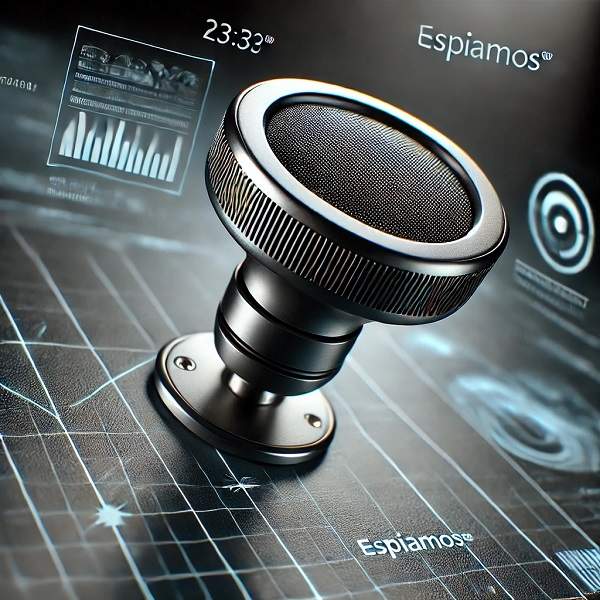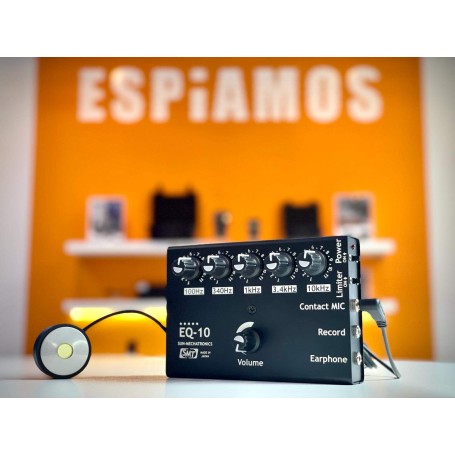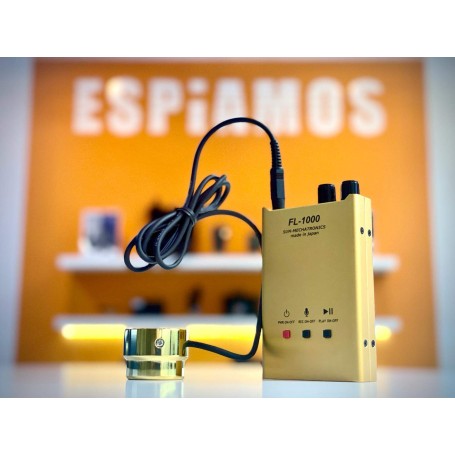Contact microphones , also known as surface microphones or piezoelectric microphones, are devices designed to pick up sounds and vibrations directly from a solid surface. Unlike conventional microphones that pick up sound waves traveling through the air, contact microphones attach to objects such as walls, windows, or pipes, capturing sound-generated vibrations in those materials.
These devices are widely used in espionage and covert surveillance , as they allow you to listen to conversations and sounds that cannot be picked up with a conventional microphone. This type of technology is ideal for discreet operations, where it is necessary to obtain information without raising suspicion. In this article, we will explore how these microphones work, their practical applications, and why they are a key tool in the field of security.

Table of Contents
- What is a Contact Microphone?
- How Do Contact Microphones Work?
- Advantages of Contact Microphones
- Practical Applications of Contact Microphones
- Contact Microphone FAQ
What is a Contact Microphone?
A contact microphone is a specialized device that transforms the vibrations of a solid surface into an electrical signal that can be processed as sound. These microphones attach to surfaces such as walls, windows, or pipes, capturing the vibrations of the material to convert them into audio signals. They are extremely useful in situations where sound waves do not propagate through the air effectively, but where the sounds generated cause vibrations that can be picked up by the microphone.
The operating principle of these microphones is very similar to that of piezoelectric microphones, as they also use piezoelectric crystals that generate an electrical signal in response to mechanical vibrations. This signal is amplified and converted into a representation of the sound originating from the surface where the microphone is placed.
How Do Contact Microphones Work?
Contact microphones work by capturing the mechanical vibrations that are generated when an object or surface is struck by sound. These vibrations, although not always perceptible to the human ear, are captured by the microphone and converted into an electrical signal thanks to a piezoelectric element. Once converted, this signal is amplified and converted into sound that can be recorded or listened to in real time.
Installing a contact microphone is relatively simple. It is placed directly on a surface that is in contact with the area to be monitored, such as a wall dividing two rooms. Vibrations generated by conversations or movements in the adjoining room are transferred through the solid structure and captured by the microphone.
Through this method, it is possible to listen to conversations and sounds in areas that would normally be inaccessible to other types of microphones, making contact microphones an extremely effective tool in espionage and surveillance.
Advantages of Contact Microphones
Contact microphones offer numerous advantages in covert surveillance situations. Below we highlight some of the main ones:
1. Sound Pickup Through Surfaces
The main advantage of these microphones is their ability to pick up vibrations through solid surfaces. This makes them useful for listening to conversations in adjacent rooms or monitoring activity in inaccessible areas without needing to be physically present on site.
2. Discreet and Easy Installation
Contact microphones are small and easy to conceal, making them an ideal choice for covert operations. They attach discreetly to surfaces and do not emit any visible signals that give away their presence.
3. Reliability in Noisy Environments
Unlike conventional microphones, contact microphones do not pick up ambient noise that travels through the air. This makes them ideal for operating in noisy environments or when unwanted sounds need to be filtered out.
Practical Applications of Contact Microphones
Contact microphones have applications in a wide variety of espionage, security and surveillance scenarios. Their ability to pick up vibrations through solid surfaces makes them an indispensable tool in a variety of situations. Below are some practical use examples and helpful tips:
1. Surveillance Through Walls in Offices or Meeting Rooms
One of the most common uses of contact microphones is for listening through walls in offices or meeting rooms where confidential conversations are being conducted. These microphones attach discreetly to the wall and pick up the vibrations generated by conversations in the next room, allowing key information to be obtained without requiring physical access to the space.
2. Vehicle Monitoring for Detection of Hidden Persons
In police or security investigations, contact microphones can detect the presence of hidden persons, such as in cases of kidnapping or human trafficking. By picking up the vibrations caused by any movement or conversation inside the car, these devices allow for discreet and efficient surveillance without the need to enter the vehicle, which is crucial in undercover operations.
3. Listening to Conversations Through Windows
Another useful application of contact microphones is the pickup of sound through windows . In spy operations where direct access to the interior of a room is impossible, contact microphones can be attached to windows and pick up the vibrations in the glass generated by conversations. This method is ideal for surveillance operations in offices, government buildings, or residences where sensitive information is handled.
4. Surveillance in Industrial Facilities
Contact microphones are also used in industrial installations to detect activities or monitor hard-to-reach areas. They can be placed on pipes or machinery to pick up conversations or sounds that could not be heard with conventional microphones. In this context, they are especially useful for detecting sabotage without alerting those responsible.
Practical Applications of Spy Stethoscopes
Spy stethoscopes have applications in a wide variety of spying and surveillance scenarios. Here are some examples:
1. Surveillance Through Walls
These microphones are used to pick up conversations through walls in situations where the operator does not have direct access to the room. This makes them ideal for corporate espionage, private investigations or counterintelligence activities.
2. Vehicle Monitoring
In investigations into criminal activity or surveillance of persons, contact microphones can be installed in vehicles to pick up conversations inside the vehicle. Thanks to their ability to pick up vibrations from the bodywork, they can record conversations inside the car.
3. Listen Through Windows
Contact microphones can also be used to listen through windows, especially in spying operations where direct access is impossible. By picking up the vibrations of the glass, clear recordings of what is happening in a room can be obtained from the outside.
Contact Microphone FAQ
1. How do you install a contact microphone on a surface?
Setting up a contact microphone is simple. It is placed directly on the solid surface you want to monitor, such as a wall or window. The microphone captures the vibrations traveling through that material and converts them into sound.
2. Are contact microphones effective for listening through thick walls?
Yes, contact microphones are very effective at picking up vibrations on coarse surfaces. However, the effectiveness will depend on the material of the wall and the intensity of the vibrations generated by the conversation or sound being monitored.
3. Do contact microphones work on surfaces like metal or glass?
Yes, contact microphones work very well on surfaces such as metal and glass, as these surfaces transmit vibrations very clearly. They are useful in scenarios such as listening through windows or in vehicles.
4. What is the pickup distance of contact microphones?
The pickup distance of a contact microphone depends on the quality of the device and the type of surface it is attached to. In general, they can pick up conversations several meters away if the vibrations are strong enough.
5. Can they pick up sounds in noisy areas?
One of the main advantages of contact microphones is that they do not pick up ambient noise, as they focus on the vibrations passing through the surface they are attached to. This makes them ideal for use in environments with a lot of ambient noise.
6. What type of recorder is compatible with contact microphones?
Contact microphones are compatible with most spy audio recorders, as long as the recorder has the appropriate connections. It is important that the recorder has good sound processing quality to ensure that the captured vibrations are converted into clear audio.
7. Do contact microphones require power?
No, contact microphones generally do not require an external power source. They work by capturing mechanical vibrations through solid materials and transforming them into electrical signals that can be recorded by a spy recorder.
8. Is it legal to use contact microphones in private investigations?
The use of contact microphones is regulated by the laws of each country. In many jurisdictions, recording conversations without the consent of the people involved can be illegal, so it is always advisable to consult with a lawyer before using these devices.
9. What are the limitations of contact microphones?
One of the main limitations of contact microphones is that their effectiveness depends on the quality of the vibrations they receive. If the vibrations are too weak or distorted by the surface material, the quality of the recording may suffer.
10. How does a contact microphone differ from a directional microphone?
A contact microphone captures vibrations directly from solid surfaces, while a directional microphone picks up sound waves from the air, focusing in a specific direction. Both are useful in spying, but for different situations.






 WhatsApp
WhatsApp Telegram
Telegram




